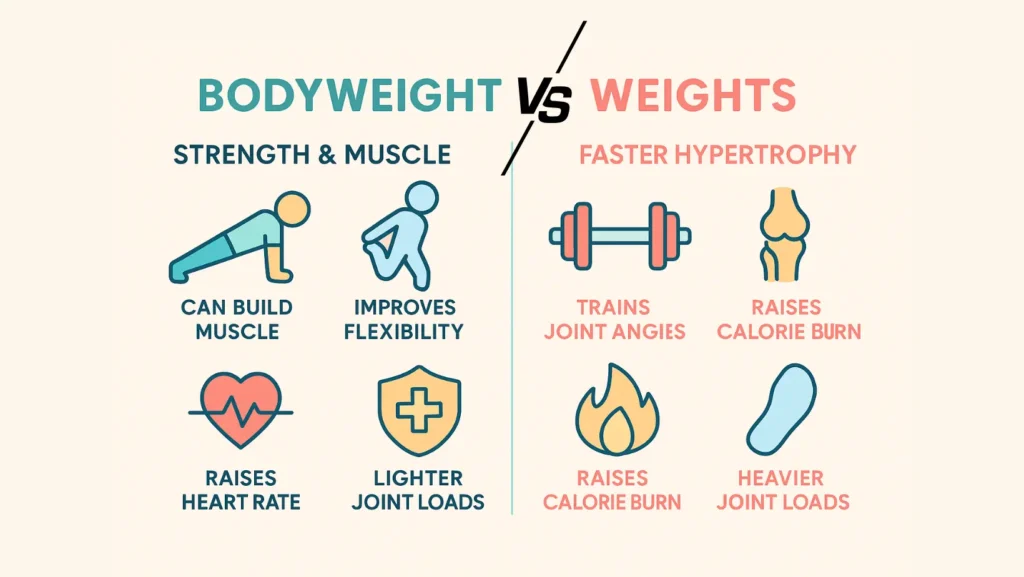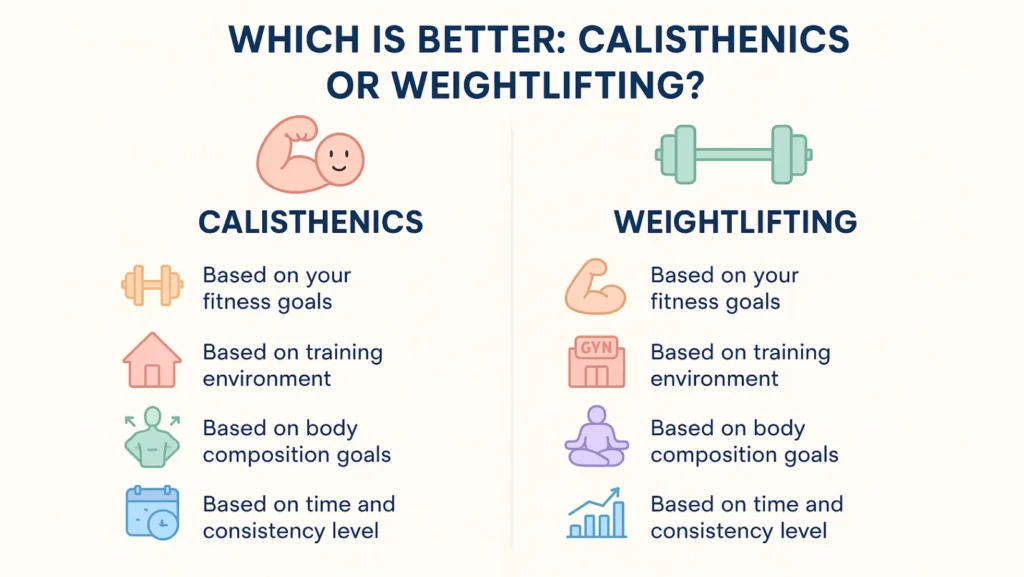Calisthenics uses your body as the resistance. Weightlifting uses external weights like dumbbells and barbells. Both can build strength, muscle, and good health. The better choice depends on what you want.
Table of Contents
ToggleIf your main goal is bigger muscles and steady load increases, weightlifting works faster. If you want better control, balance, and training you can do anywhere, calisthenics is the better pick. People who want a mix of size, movement, and lower cost often blend both styles.
Calisthenics vs Weight Training Differences
What Is Calisthenics? (Bodyweight Resistance Training Explained)
Calisthenics is training that uses your body as resistance. You use push-ups, pull-ups, squats, lunges, and planks. You do not need heavy machines. You build control, balance, and core strength. You learn to move well. Many moves also improve joint stability. You can train at home or in a park. You can change difficulty by changing the angle, tempo, or leverage of a move.
What Is Weightlifting? (Free Weights, Machines, and Barbells)
Weightlifting uses external load. You lift dumbbells, barbells, kettlebells, or use machines. You can isolate a muscle or train many muscles at once. You add weight to create more challenge. You can test one-rep strength and track progress easily. For size and raw force, weightlifting is a direct path. You often need a gym or some equipment.
Core Differences: Resistance Source, Scalability, and Progression
The biggest difference is the resistance source. Calisthenics uses bodyweight. Weightlifting uses external load. Calisthenics and weightlifting also differ in how you progress. In weightlifting, you add plates or increase reps. In calisthenics, you change leverage, do harder variations, or add weighted vests. Both need progressive overload to get stronger or build muscle.
Accessibility: Minimal Equipment vs Gym Setup
If you want simple and cheap, calisthenics wins. A pull-up bar and open space will do. If you want heavy load and precision, weightlifting needs gear. Gyms offer racks, plates, and machines. Choose by what you can access and what you enjoy.
Calisthenics vs Weightlifting Pros and Cons
Advantages of Calisthenics (Mobility, Balance, Coordination)
Calisthenics improves how you move. It builds balance and control. It trains multiple muscles together. It helps with posture and everyday tasks. You get better joint awareness. You gain functional strength that you use outside the gym.
Drawbacks of Calisthenics (Plateau and Skill Limitations)
A limit is adding a heavy, measurable load. Some bodyweight goals take a long time. Moves like handstand push-ups require practice. You may hit a plateau unless you use weighted vests or advanced progressions. That is a real trade-off in calisthenics vs weightlifting.
Advantages of Weightlifting (Progressive Overload, Muscle Isolation)
Weightlifting lets you add precise weight. You can overload a muscle directly. This speeds muscle growth for many people. You can isolate weak parts. You can measure progress by plates and numbers. For pure mass or maximal strength, weightlifting is efficient.
Drawbacks of Weightlifting (Equipment Dependency, Injury Risk)
You need equipment and space for heavy lifting. Poor form under heavy load raises injury risk. Machines sometimes reduce natural movement. Weight work can limit mobility unless you add mobility routines.
Which Is Better for Beginners — Calisthenics or Weightlifting?
For a beginner, calisthenics builds base strength and teaches movement. Basic weightlifting teaches form and adds strength fast. If you must choose, start with calisthenics and light weightlifting to learn control and safe technique. Your choice should fit access, goals, and time.
Bodyweight Training vs Weights: Benefits Breakdown
Strength and Muscle Development Potential
Both methods build strength. Weightlifting often produces faster hypertrophy (muscle growth). That is because you can add a heavy external load easily. Calisthenics can grow muscle too. Use higher volume, slow negatives, or added weight to push growth. The key is progressive overload and consistent effort.
Flexibility and Functional Movement Comparison
Calisthenics usually improve flexibility and functional movement more. It trains full-range moves. Weightlifting can improve strength at specific joint angles. Add mobility drills to weight training to match functional gains.
Fat-Burning and Calorie Expenditure
Fat loss depends on calories and intensity. Short, intense calisthenics circuits raise heart rate and burn calories. Heavy weightlifting increases muscle, which raises daily calorie burn over time. Either style supports fat loss when paired with a diet.
Injury Prevention and Recovery Differences
Calisthenics often uses lighter joint loads and can be better for older trainees or rehab. Weightlifting can stress joints under heavy load if form is poor. Recovery depends on volume, sleep, nutrition, and your training history. Both need proper warm-up and rest.
Calisthenics vs Weightlifting Workout Plan
Sample Beginner Calisthenics Workout (Push-Ups, Pull-Ups, Dips)
Warm up for five minutes. Then do three rounds. Keep rest light.
- Push-ups: 8 to 12 reps.
- Assisted pull-ups or negative pull-ups: 4 to 8 reps.
- Dips or bench dips: 8 to 12 reps.
- Bodyweight squats: 12 to 20 reps.
- Plank: 30 to 60 seconds.
This calisthenics workout plan builds base strength and control. Increase reps or try harder variations as you improve.
Sample Beginner Weightlifting Workout (Compound Lift Focus)
Warm up for five minutes. Then perform three sets of each. Rest two minutes between heavy sets.
- Squat: 6 to 10 reps.
- Bench press: 6 to 10 reps.
- Bent-over row: 6 to 10 reps.
- Romanian deadlift: 6 to 10 reps.
- Overhead press: 6 to 10 reps.
This weightlifting workout plan targets major muscle groups with heavy, measurable loads.
Intermediate Progression — Adding Difficulty and Load
For calisthenics, progress by: slowing the tempo, adding isometric holds, changing leverage, or using a weight vest. For weightlifting, progress by adding small weight increments, increasing sets, or using controlled tempo. Track progress in a log to ensure steady gains.
How to Mix Calisthenics and Weightlifting in a Hybrid Plan
A hybrid plan can give the best of both worlds. Use calisthenics for control and mobility. Use weightlifting for heavy loading. Example split: two weight days and two bodyweight days. Or pair a heavy lift with a calisthenics finisher. Balance volume to avoid overtraining.
Which Is Better: Calisthenics Or Weightlifting?
Deciding between calisthenics and weightlifting depends on what you want. If your goal is maximal muscle size and heavy strength, weightlifting gives direct loading. If your goal is movement quality, balance, and body control, calisthenics wins. If you want both, you can combine them. Pick the main goal first, then match your training style to it.
Based On Your Fitness Goals — Strength, Endurance, Or Physique
If you want raw one-rep maxes and visible muscle mass, focus on weightlifting. If you want muscular endurance, agility, and better body control, choose calisthenics. For a sculpted look with good movement, mix both.
Based On Training Environment — Home Vs Gym
If you train at home with little gear, calisthenics fits best. If you have gym access and want heavy progression, weightlifting fits. A simple pull-up bar and dumbbell set let you combine both.
Based On Body Composition Goals — Muscle Vs Mobility
To gain size, use progressive external load and follow a solid weightlifting plan. To gain mobility and usable strength, use calisthenics. To keep muscle and add control, pair calisthenics with weightlifting.
Based On Time And Consistency Level
If you have short daily windows, bodyweight sessions can be quick and effective. If you prefer measured lifts and steady weekly progression, allocate longer sessions for weightlifting. Consistency beats the method.
Calisthenics Vs Weightlifting For Muscle Growth
Which Builds Muscle Faster?
Generally, weightlifting builds muscle faster for most people. You can add small weight increments to increase mechanical tension. Calisthenics can also build muscle, but you must find ways to increase load or change leverage to keep progressing.
Why Muscle Hypertrophy Differs Between The Two
Hypertrophy (muscle growth) needs tension, volume, and recovery. Weightlifting gives high mechanical tension easily. Calisthenics offers time under tension and metabolic stress. Both work when you control volume and recovery.
The Science Behind Bodyweight Vs External Load Stimulus
Muscle fibers respond to force and fatigue. External weights allow predictable force increases. Bodyweight moves change joint angles and leverage to increase force. Both methods can activate fast and slow muscle fibers when programmed correctly.
Can You Bulk With Calisthenics? (Progressive Overload Explained)
Yes, you can bulk with calisthenics. Methods: add a weighted vest, slow negatives, pause reps, increase sets, or change angles. Track volume and calories to ensure you are in a slight calorie surplus for muscle gain.
Calisthenics Vs Weightlifting For Fat Loss And Definition
Calorie Burn Comparison
Calorie burn depends on intensity and duration. Fast calisthenics circuits can burn many calories per session. Heavy weightlifting increases muscle mass and resting metabolic rate. The best choice is the one you do consistently.
Metabolic Adaptation And Muscle Tone
As you train, your metabolism adapts. Weightlifting that builds muscle increases long-term calorie needs. Calisthenics can create a strong-looking tone by improving muscle density and posture. Combine training with diet for visible definition.
High-Intensity Training Methods For Each Style
For calisthenics, use circuits, EMOMs, and AMRAPs to boost heart rate. For weightlifting, use supersets, short rest, and higher rep sets to add metabolic stress. Both styles can be adjusted for fat loss.
Combining Cardio With Strength For Optimal Fat Loss
Pair strength training with moderate cardio. Use 2 to 3 strength sessions and 2 cardio or high-intensity calisthenics sessions weekly. Keep protein high to protect muscle during calorie loss.
Common Mistakes In Calisthenics And Weightlifting
Overtraining And Lack Of Recovery
Training too often without rest reduces gains and raises injury risk. Listen to fatigue cues. Plan rest days. Sleep and nutrition matter as much as workouts.
Poor Form And Injury Risk
Rushing weight or reps breaks form. In calisthenics, poor scapular control or hip hinge errors cause pain. In weightlifting, bad lifting patterns raise injury risk. Learn the basics and progress slowly.
Ignoring Mobility And Flexibility Work
Skipping mobility causes stiffness and limits performance. Add daily joint drills for shoulders, hips, and spine. Mobility prevents pain and supports heavier loads.
Skipping Warm-Ups And Cooldowns
A short warm-up primes muscles and nerves. A cooldown helps recovery. Both reduce injury risk and make performance safer.
FAQs
Which Is Better For Beginners: Calisthenics Or Weightlifting?
Both work well for beginners. Start with basic calisthenics to learn control and posture. Add light weightlifting to teach load handling and build strength safely.
Can You Build Muscle With Calisthenics Only?
Yes, you can build muscle with a solid calisthenics program that uses progressive overload, increased volume, and added resistance like vests or weighted holds.
Is Weightlifting Better For Body Recomposition?
Weightlifting boosts muscle and strength efficiently, aiding body recomposition. Mixing calisthenics helps with movement quality, while weight work changes body composition faster.
Which Burns More Calories: Calisthenics Or Weights?
It depends on intensity. Intense calisthenics circuits burn many calories short term. Weightlifting builds muscle that increases long-term calorie burn. Combine both for the best results.
Can You Combine Calisthenics And Weightlifting In One Routine?
Yes. A hybrid approach gives the load from weightlifting and the control from calisthenics. Alternate days or pair a heavy lift with a calisthenics finisher.
What’s The Main Difference Between Bodyweight Training And Weights?
The main difference is the resistance source. Bodyweight training uses your mass. Weightlifting uses external load. Both require progressive overload to improve.
Is Calisthenics Enough For Gaining Size And Strength?
Yes, with planned progression and enough calories. Add weighted variations and volume in your calisthenics workout plan to reach hypertrophy goals.
Does Calisthenics Improve Athletic Performance?
Yes. Calisthenics enhances balance, coordination, and movement control, all of which help athletic tasks like jumping, sprinting, and quick direction changes.
Can Women Do Both Calisthenics And Weightlifting Safely?
Yes. Women can safely do both styles. Both build strength and shape. Progress slowly and focus on form to reduce injury risk.
Which Is Better For Flexibility And Functional Strength?
Calisthenics tends to improve flexibility and functional strength more. To match it, include mobility work with your weightlifting sessions.
How To Transition From Calisthenics To Weightlifting?
Start by learning basic lifts with light weights. Keep calisthenics for mobility. Gradually swap some bodyweight sessions for weight sessions while tracking load and form.
Is Equipment Necessary For Effective Strength Gains?
No. You can gain strength with bodyweight training. Equipment speeds up heavy progression and makes the load more measurable. Use what you can access.
Can You Bulk With Calisthenics?
Yes. A calisthenics bulk needs more volume, added weight, and a calorie surplus. Track progress and adjust load or reps weekly to ensure growth.

This article is medically reviewed by Dr. Chandril Chugh, Board-Certified Neurologist, providing expert insights and reliable health information.
Dr. Chandril Chugh is a U.S.-trained neurologist with over a decade of experience. Known for his compassionate care, he specializes in treating neurological conditions such as migraines, epilepsy, and Parkinson’s disease. Dr. Chugh is highly regarded for his patient-centered approach and dedication to providing personalized care.










